Add this eBook to your basket to receive access to all 2,944 records. Our indexes include entries for the spelling gibson. In the period you have requested, we have the following 2,944 records (displaying 2,351 to 2,360): These sample scans are from the original record. You will get scans of the full pages or articles where the surname you searched for has been found. Your web browser may prevent the sample windows from opening; in this case please change your browser settings to allow pop-up windows from this site. Boys entering Uppingham School
(1892)
The public school at Uppingham in Rutland was founded by Archdeacon Johnson in 1584. A roll of scholars from 1824 to 1905 was edited by J. P. Graham, and published in 1906. This was a revision and updating of an 1894 edition of the roll, the great bulk of the work having been done by Mrs Mullins. The roll is arranged by year, and within each year by term of entrance, and then alphabetically by surname within each term. Each boy's name is given, surname first, with an asterisk where known (in 1906) to have died. Then there is month and year of birth, father's name (most often just surname and initials) and address (at entrance). Where the boy represented the school at Rugby football (XV) or cricket (XI), that is indicated. After the month and year of leaving the school, there is a brief summary of achievements in later life, and, where known, address as in 1906. From 1875 onwards the house within the school is also noted, with these abbreviations: A., Mr Constable's House; B., Brooklands; C., West Bank; E., Mr J. Gale Thring's House; F., Fircroft; Fgh., Farleigh; H., Highfield; L., The Lodge; L. H., Lorne House; M., Meadhurst; N., The Hall; R., Redgate; R. H., Red House; S., School House; and W. D., West Deyne. | Sample scan, click to enlarge
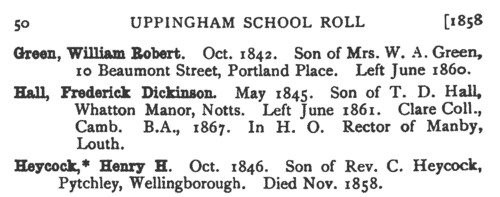
| Clergy on the committees of the Anglican Church Congress
(1892)
The 32nd annual congress of the Anglican church was held at Folkestone on the 4th, 5th, 6th and 7th October 1892. Moral and social questions were discussed as well as the purely theological and ecclesiastical - The Relation between the Authority of the Bible and the Authority of the Church; the Attitude of the Church towards Labour Combinations; the Work of the Church of England on the Continent; the Result of the Neglect of Religious Instruction in Elementary Schools; Canon Law; the Duty of the Church to the Agricultural Population; Christian Ethics; Meeting of Women; the Temperance Movement; Physical Recreation; the Permanent Value of the Old Testament; Thrift and the Poor Law; Vivisection; Preparation for Clerical Orders, and of Laymen for Evangelism; Foreign Missions; the Duty of the Church towards Soldiers; Christian Doctrine and Christian Life; Preaching in the Church of England; and the Church's Work at the Seaside. The sermons, letters, addresses and discussions (of clergy and laity) were all published in this, the official report of the congress. The report also included lists of the members of the committees, divided into clergy and laity: this is the index to the clergy. | Sample scan, click to enlarge

| Guarantors of the Anglican Church Congress
(1892)
The 32nd annual congress of the Anglican church was held at Folkestone on the 4th, 5th, 6th and 7th October 1892. Moral and social questions were discussed as well as the purely theological and ecclesiastical - The Relation between the Authority of the Bible and the Authority of the Church; the Attitude of the Church towards Labour Combinations; the Work of the Church of England on the Continent; the Result of the Neglect of Religious Instruction in Elementary Schools; Canon Law; the Duty of the Church to the Agricultural Population; Christian Ethics; Meeting of Women; the Temperance Movement; Physical Recreation; the Permanent Value of the Old Testament; Thrift and the Poor Law; Vivisection; Preparation for Clerical Orders, and of Laymen for Evangelism; Foreign Missions; the Duty of the Church towards Soldiers; Christian Doctrine and Christian Life; Preaching in the Church of England; and the Church's Work at the Seaside. The sermons, letters, addresses and discussions (of clergy and laity) were all published in this, the official report of the congress. The congress cost £1,822 14s 1d to hold; the receipts were £1,547 18s 5d, leaving a deficiency of £274 15s 8d, which was raised by call on the guarantors. The full list of the guarantors (who had each pledged from 10s to £200 beforehand) was printed in the official report, and this, together with the names of a handful of donors, is indexed here. | Sample scan, click to enlarge

| Speakers at the Anglican Church Congress
(1892)
The 32nd annual congress of the Anglican church was held at Folkestone on the 4th, 5th, 6th and 7th October 1892. Moral and social questions were discussed as well as the purely theological and ecclesiastical - The Relation between the Authority of the Bible and the Authority of the Church; the Attitude of the Church towards Labour Combinations; the Work of the Church of England on the Continent; the Result of the Neglect of Religious Instruction in Elementary Schools; Canon Law; the Duty of the Church to the Agricultural Population; Christian Ethics; Meeting of Women; the Temperance Movement; Physical Recreation; the Permanent Value of the Old Testament; Thrift and the Poor Law; Vivisection; Preparation for Clerical Orders, and of Laymen for Evangelism; Foreign Missions; the Duty of the Church towards Soldiers; Christian Doctrine and Christian Life; Preaching in the Church of England; and the Church's Work at the Seaside. The sermons, letters, addresses and discussions (of clergy and laity) were all published in this, the official report of the congress. | Sample scan, click to enlarge
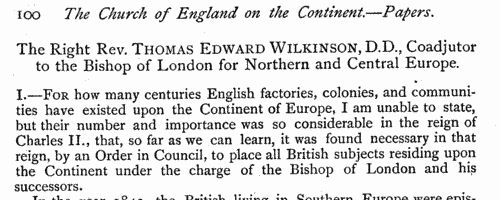
| Boys entering Haileybury College, Hertfordshire
(1893)
Haileybury College, near Hertford, was founded by the East India Company in 1806, and incorporated by Royal Charter in 1864. This register of pupils entering the school from 1862 to 1931 was edited by a master there, Laurence Arthur Speakman. The boys are listed by term of joining the school, and then alphabetically by name (in bold), surname first (in capitals). There is then usually a precise birthdate, and the name and address of his father; his period at the school, starting with abbreviations to indicate the house to which he belonged (B., Batten; B. F., Bartle Frere; C., Colvin; E., Edmonstone; Ha., Hailey; Hi., Highfield; L., Lawrence; Le B., Le Bas; M., Melvill; Th., Thomason; T., Trevelyan), and the first and last forms attended (e. g., IV., fourth form). Where a member of a school team there is then an indication (e. g., XI., cricket). For some pupils, with whom the school had lost touch, Speakman was only able to record the details of their time at Haileybury; but for most a brief career synopsis is then given, and current address (as in 1931) or date of death.
| Sample scan, click to enlarge
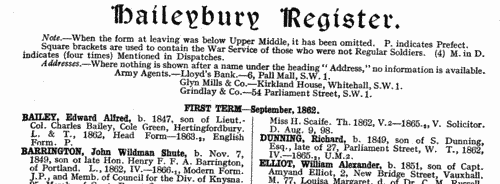
| Boys entering King William's College, Isle of Man
(1893)
King William's College at Castletown on the Isle of Man was established in 1830. By 1928 about 290 boys were being educated there, 'of whom three-fourths are boarders, and the remainders sons of natives or residents in the Island.' Boys entered the junior school about 9 or 10 years of age, the upper school about 13; boys over 13 were not admitted 'unless attainments and character are specially satisfactory'. There were 'several nominations for the sons of clergy and others'.
Editions of the college register were published in 1905 and 1927. When this third edition was prepared, in 1956, it was felt unnecessary to repeat the whole of the register from 1830 onwards, a new starting point being chosen as September 1886, when the reverend Frank Bridgman Walters took office as principal.
The items are arranged alphabetically within term of entry; surname is given first, in bold, and then full christian names; then, to the right, in bold, precise date of birth, school house, and month of leaving the school. The abbreviations for houses are: C, Colbourne; D, Dickson; H, Hunt; Ha, Hangoside; J, Junior House; R, Raglan; S, School House (formerly Principal's); T, town houses occupied by masters who took in boys prior to September 1889; Tr, Trafford's; W, Walters.
Each entry then gives the boy's father's name (surname and initials) and address at that time; school honours (such as Prae., praepositor, XI, school cricket team); a career synopsis; and finally, in italics, to the right, year of death, or present address in 1956, if known. | Sample scan, click to enlarge
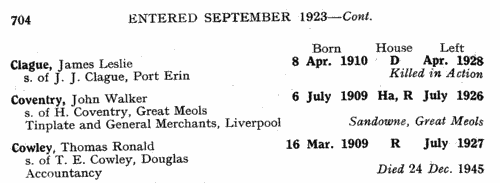
| Boys entering Uppingham School
(1893)
The public school at Uppingham in Rutland was founded by Archdeacon Johnson in 1584. A roll of scholars from 1824 to 1905 was edited by J. P. Graham, and published in 1906. This was a revision and updating of an 1894 edition of the roll, the great bulk of the work having been done by Mrs Mullins. The roll is arranged by year, and within each year by term of entrance, and then alphabetically by surname within each term. Each boy's name is given, surname first, with an asterisk where known (in 1906) to have died. Then there is month and year of birth, father's name (most often just surname and initials) and address (at entrance). Where the boy represented the school at Rugby football (XV) or cricket (XI), that is indicated. After the month and year of leaving the school, there is a brief summary of achievements in later life, and, where known, address as in 1906. From 1875 onwards the house within the school is also noted, with these abbreviations: A., Mr Constable's House; B., Brooklands; C., West Bank; E., Mr J. Gale Thring's House; F., Fircroft; Fgh., Farleigh; H., Highfield; L., The Lodge; L. H., Lorne House; M., Meadhurst; N., The Hall; R., Redgate; R. H., Red House; S., School House; and W. D., West Deyne. | Sample scan, click to enlarge
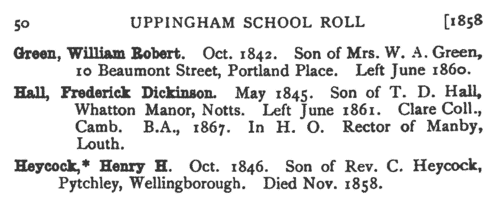
| Boot and Shoe Operatives: Aberdeen
(1894)
The Annual Registry of the National Union of Boot and Shoe Operatives gives full name, age, and number on the register. | Sample scan, click to enlarge
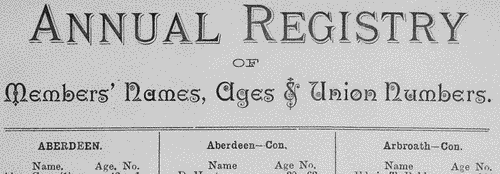
| Boys entering Fettes College, Edinburgh
(1894)
Fettes College, Edinburgh, was opened in 1870 under the terms of a trust 'for maintenance, education, and outfit of young people whose parents have either died without leaving sufficient funds for that purpose, or who, from innocent misfortune during their own lives, are unable to give suitable education to their children'. In 1923 this edition of the Fettes College Register was published; in it the compilers sought to set out for each boy who had attended the college a brief synopsis of what was known about his time at the school, his subsequent career, and date and place of death, or address as of 1923. After each name there is a letter in brackets indicating the house to which the pupil belonged - (C.) Carrington House; (G.) Glencorse House; (K.) Kimmerghame House; (M.) Moredun House; (S.) Schoolhouse. An asterisk indicates that the boy was a foundationer, i. e. supported by the foundation; a dagger that he was a foundation scholar. VIA. indicates Upper Form; Mods. Modern School; Army Cl., Army Class; S. P., School Prefect; xx. First Rugby Football Twenty; xv. First Rugby Football Fifteen; xx. cap. Caps occasionally given to the five (or fewer) next to the First Fifteen after 1875; xi. First Cricket Eleven; viii. Gymnastic Eight; Trs. Prizes and Exhib., Trustees' Prizes and Exhibitions; Govs. Prizes and Exhib., Governors' Prizes and Exhibitions; Schol., scholarship; M., married. Month and year of birth is given in square brackets. | Sample scan, click to enlarge
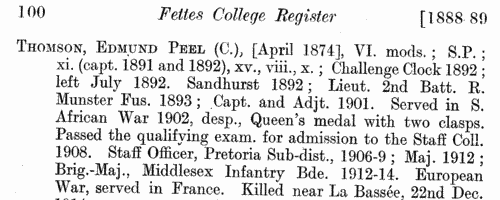
| Boys entering Giggleswick School
(1894)
The school at Giggleswick in the West Riding of Yorkshire dates from at least 1507, but no register of the boys attending there has survived earlier than one started by the headmaster, the reverend George Style, in 1875. When the bursar, H. L. Mullins, prepared this, 'The Giggleswick School Register', printed in 1913, he was able to compile general details of some scholars from earlier years, but the concerted, reasonably complete, account starts in 1859. The details are arranged by term of entry, then alphabetically by surname and christian name. Typically each description gives full name; date of birth; name and address of father; date of leaving. Where known, Mullins then added a brief career synopsis, present address in 1913, or date of death. From 1869 onwards boarders were admitted to the school, and where it is known that a boy was a day scholar, the word (Town) is added after his name. | Sample scan, click to enlarge
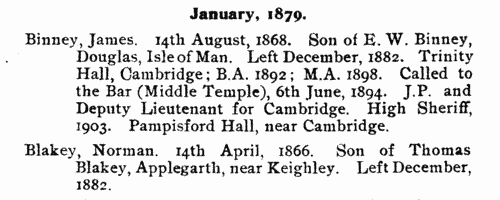
|
Research your ancestry, family history, genealogy and one-name study by direct access to original records and archives indexed by surname.
|











